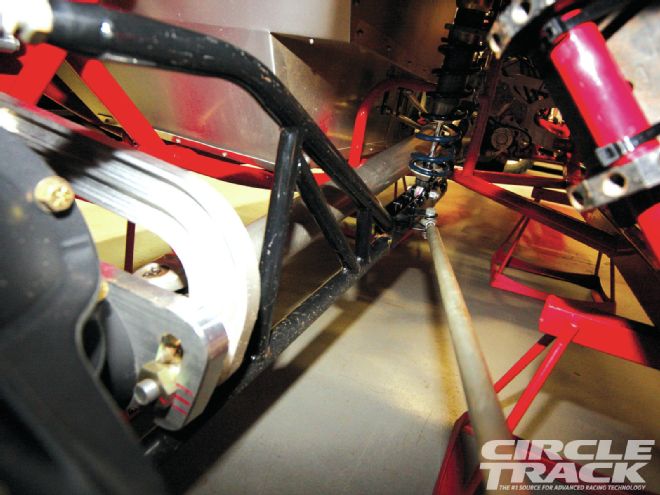
Let's face it, the driveshaft isn't exactly the sexiest part on your race car--or your personal car, or even a combination of the two for that matter. But considering that it's impossible to move all that torque produced by that expensive race engine of yours to the rear wheels without it, the humble driveshaft is pretty necessary.
Even on the most complex, high-end race cars, the driveshaft's form and function have both been whittled down into their simplest essence: a hollow tube with universal joints on either end to provide a solid mechanical connection between the output shaft of the transmission and the pinion on the rearend. It's as simple as that. When the driveshaft is right and doing its job correctly, it's practically noise-free, vibration-free, spinning with minimal drain on the torque the engine is sending to the rear wheels and out of the way so that the driver can concentrate on his job. Driveshafts are sort of like the offensive linemen in a football game, you only notice them when they screw up.
And when they do screw up, a driveshaft failure all too often ends up being a big deal. A vibration can quickly turn into early wear in your transmission or rearend, or a broken shaft that leaves you stranded on the racetrack. Worst of all, broken driveshafts have been known to break through the safety hoop and tear into the driver's compartment, injuring the driver.
To help make sure this doesn't happen to you, we spoke with two leaders in the industry, Mark Pozzuoli of The Axle Exchange and Jeff Neal of Quarter Master, about the latest developments in driveshaft technology when it comes to racing, how to spot a poorly made driveshaft and even maintenance tips.
Materials
Although the grade of materials may vary widely, all racing driveshafts are constructed from one of three materials: steel, aluminum, or carbon fiber. What you choose will depend primarily on the restrictions in your rulebook and the restrictions on your checkbook.
Most Street Stock-level classes mandate a "stock style" driveshaft, which essentially means it has to be constructed from the same material as the OEM shaft. In most cases this means an old-school steel driveshaft. But just because you can't upgrade to lighter weight aluminum, that doesn't mean you can't improve your performance by ditching the stock shaft. A high-quality, racing grade driveshaft--even if it is constructed from steel--will usually be lighter than the stock unit and almost certainly will be balanced better and exhibit less runout than a stock driveshaft. In plain English, "runout" equates to straightness. Less runout means a truer driveshaft that will balance better and introduce fewer damaging vibrations into your driveline.
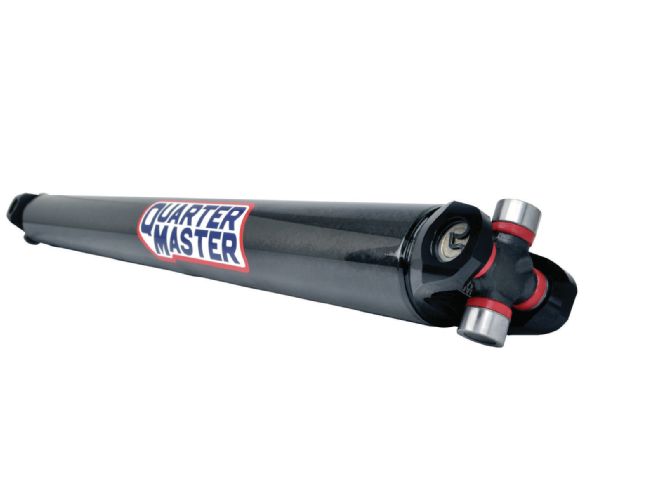 Quarter Master’s carbon-fiber driveshaft is top of the line when it comes to driveshafts for short track racing. It’s approximately 20 percent lighter than an equivalent aluminum driveshaft, features a special coating to protect the carbon-fiber tube from scratches and other forms of damage, and is made so precisely most don’t even require balancing weights.
Quarter Master’s carbon-fiber driveshaft is top of the line when it comes to driveshafts for short track racing. It’s approximately 20 percent lighter than an equivalent aluminum driveshaft, features a special coating to protect the carbon-fiber tube from scratches and other forms of damage, and is made so precisely most don’t even require balancing weights.
Racing also introduces completely new levels of stress on the driveshaft. An OEM shaft that performed well in a street application where the rpm levels rarely ever exceed 5,000, may not hold up as well in circle track racing where the rpms can reach 7,500 or more for extended periods. A small imbalance becomes a big one when the rpms go up, as do any weaknesses. Racing also introduces shocks to the driveshaft that it never sees on the street. Any time the wheels break loose and then gain traction again it can send a shockwave through the rearend and through the driveline all the way up to the crankshaft.
That's a major reason why Neal cautions against having your local driveshaft shop prepare a driveshaft for you if it isn't already involved in racing. "A lot of times with race cars you will change the rearend or transmission so the driveshaft will need to be changed," he says. "If you just go to your local shop and have them cut the shaft and resize it, they may be able to do the work up to the quality required for racing, or they may not. If all they do is street work and aren't involved in racing, you need to be careful."
The next step up in the materials hierarchy is aluminum. Aluminum driveshafts are significantly lighter than equivalent steel and the lowered rotating weight means the entire driveline is able to spin up faster, making for a race car that accelerates out of the turns harder. Aluminum driveshafts are quite popular in racing because they offer a real performance advantage over steel shafts without being too much more expensive.
At the top of the line are carbon-fiber driveshafts. When done right, carbon-fiber driveshafts can be incredibly light. But they are expensive, not only because carbon fiber is expensive but also because a carbon-fiber driveshaft is more difficult to manufacture. For example, with a steel driveshaft, the ends can simply be welded in place. But that's not possible with carbon fiber. Instead, the ends must be bonded to the tube.
Measuring
Purchasing a driveshaft custom-made to your application isn't difficult, but it is important to get it right because an improperly sized driveshaft can cause real problems. Too short and the slip yoke can come all the way out of the transmission and leave you stranded on the track. Too long and the end of the driveshaft can be smashed into the transmission causing expensive damage.
To measure for proper driveshaft length, begin by making sure the car is at ride height. You will need to be able to crawl around underneath it, so getting the car on wheelstands is a good idea. Just make sure it isn't raised with jackstands underneath the framerails so that the suspension is in full droop. Obviously, the rearend and transmission you'll be racing have to be in place and fully assembled.
Next, take the slip yoke that will be used on the final driveshaft (or one that's just like it) and insert it into the transmission's tailhousing until it bottoms out. Pull it back out 3/4 to 1 inch--this is your safety margin to make sure you aren't banging the slip yoke into the transmission's output seal once the racing gets started. Now, measure the distance between the centers of the U-joints on the transmission and rearend.
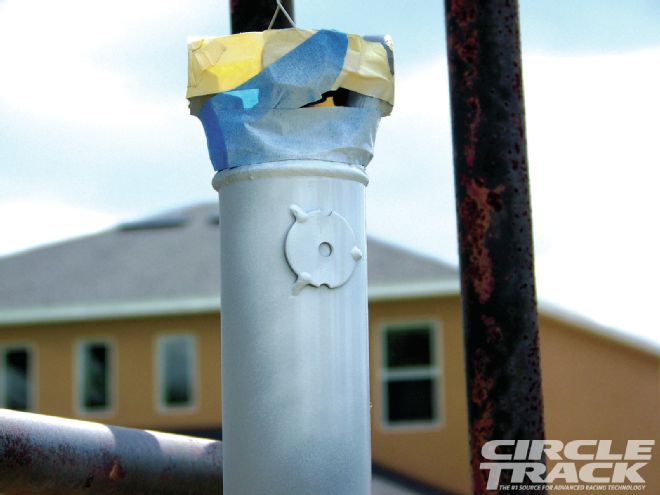 A “washer” like this is typically welded onto a driveshaft to help balance it. A properly balanced driveshaft will help eliminate vibrations, but if you see a lot of weights like this on a driveshaft it’s a sign that the shaft was either way out of balance to begin with or the technician doing the work isn’t doing good work. Either way, it’s usually a good idea to avoid a driveshaft manufacturer that has to use a lot of weight to balance its driveshafts.
A “washer” like this is typically welded onto a driveshaft to help balance it. A properly balanced driveshaft will help eliminate vibrations, but if you see a lot of weights like this on a driveshaft it’s a sign that the shaft was either way out of balance to begin with or the technician doing the work isn’t doing good work. Either way, it’s usually a good idea to avoid a driveshaft manufacturer that has to use a lot of weight to balance its driveshafts.
Give that measurement to your driveshaft builder as well as the slip yoke. If you're using an old slip yoke and plan to have your builder purchase and use a new one, make sure he knows the exact brand and part number of the slip yoke you used to measure.
Judging Quality
Both Pozzuoli and Neal agree that two of the most important factors when it comes to making sure you have a good quality driveshaft are straightness (lack of runout) and a precision balance.
"The first step," Pozzuoli says, "is to make sure the tubing you use is as straight as possible. We buy only the top quality tubing from Alcoa for our aluminum driveshafts. You can only buy it in short lengths because they can only throw the laser out so far to check for straightness, but it makes a difference. But you can only make the tubing so straight right off the bat, so you have to go in and straighten it manually if necessary."
Most driveshaft manufacturers have developed their own processes for straightening tubing, so we won't spend time on exactly how it's done. But making sure the tubing is absolutely as straight as possible is important in order to make the balance job more precise.
Neal says Quarter Master technicians take pride in producing driveshafts that use only minimal balance weights, and their process for producing carbon-fiber driveshafts is so precise that they often require no weights at all.
One clue you can look for to gauge the quality of work done balancing the driveshaft is to look at how many weights have been attached to either end of the shaft. Pozzuoli says you should never see weights 180 degrees apart from each other on the same side of the shaft. This is a sign that the technician had trouble finding the right spot to add weights, because weights placed opposite each other essentially wipe each other out leaving you right back where you started.
"You also want to make sure your manufacturer uses high quality U-joints and yokes," Pozzuoli adds. "In my book, I've seen three levels of quality. You have Chinese, cheap American, and then top-shelf American. The top-of-the-line stuff really isn't that much more expensive than the cheap stuff, so I think it's always a good idea to get the quality U-joints, like Spicer or Dana."
Maintenance
Because driveshafts are highly stressed components of the race car, they should be inspected regularly to catch any potential problems. Check the U-joints for slop or slack. Any looseness will cause them to wear and potentially fail faster. Just be sure to get your hands on both the driveshaft and yoke when you check for slack, you don't want to confuse it for backlash in either the ring-and-pinion or the transmission for play in the U-joints.
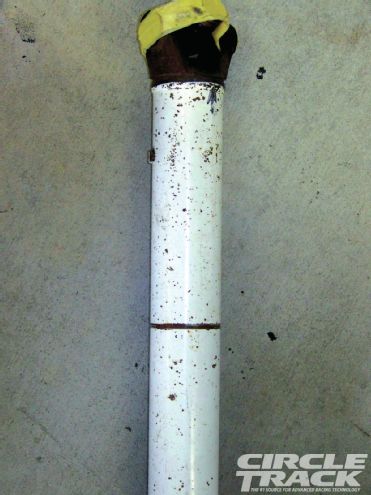 Here’s a good example of a driveshaft that’s ready for the trash bin. Something happened during a race to cause some other component of the race car to come into contact with the tubing. When whatever it was came into contact with the rapidly spinning shaft it didn’t take long to create a groove that will significantly weaken the shaft.
Here’s a good example of a driveshaft that’s ready for the trash bin. Something happened during a race to cause some other component of the race car to come into contact with the tubing. When whatever it was came into contact with the rapidly spinning shaft it didn’t take long to create a groove that will significantly weaken the shaft.
If you do notice slack, the best fix is almost always to simply replace the U-joints. While you have them out, make sure to check the U-joint bores in the driveshaft and yoke. If they are oblong, worn or otherwise out of shape, you will need to have that repaired.
Next, visually check to make sure the yoke hasn't bottomed out on the transmission's tailshaft. If this has happened, you can have damage to both the driveshaft and the transmission. This can sometimes happen even when the driveshaft is sized properly if the car has been in an accident or raced on an extremely rough track.
Do not forget to visually inspect the tubing itself. Be on the lookout for dents, scratches or grooves cut into the tubing. Sometimes if the shaft is allowed to rub up against another component in the chassis, it can cut a groove in the tubing. This will significantly weaken the integrity of the tubing, so if you see this the drivehshaft will need to be repaired or replaced.
Finally, watch out for chains or rope limiting the travel of your rearend. "Unfortunately, I've seen this happen quite often," Neal says. "Teams won't have some way of limiting the downward travel of the rearend, so when they put the car up on jackstands the only thing that stops the rearend is when the driveshaft hits the safety hoop. This definitely isn't good for the driveshaft, and the fix is easy."
The Next Step
Carbon-fiber driveshafts have only gained popularity in short track racing in the last few years. But they are becoming very popular in the Dirt Late Model classes. Neal says that a quality carbon-fiber driveshaft can not only save 20 percent in weight versus an already lightweight aluminum driveshaft, but it also has several other benefits.
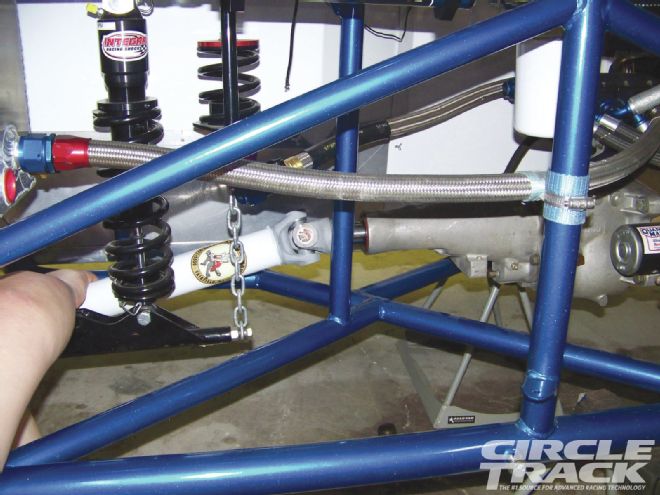 Some racers will worry about trying to keep the U-joints in the driveshaft as straight as possible to minimize rolling friction if the U-joints have to spin at too sharp an angle. But if you use high-quality U-joints you can gain more by increasing your pinion angle to improve traction coming out of the turns than you can save by keeping the joints in the driveshaft as straight as possible.
Some racers will worry about trying to keep the U-joints in the driveshaft as straight as possible to minimize rolling friction if the U-joints have to spin at too sharp an angle. But if you use high-quality U-joints you can gain more by increasing your pinion angle to improve traction coming out of the turns than you can save by keeping the joints in the driveshaft as straight as possible.
"The weight savings is nice," Neal says, "but that's almost minor compared to the other benefits. First, the critical speed of the carbon-fiber shaft is much higher than for either aluminum or steel. Critical speed is the maximum rpms that the driveshaft can safely spin. So if the critical speed is 9,000 rpm on an aluminum driveshaft, it will be closer to 12,000 on the carbon shaft.
"Also, the carbon-fiber driveshaft is safer. We put a coating on all of our carbon-fiber driveshafts that protects them from scratches, nicks or wear, so they are pretty durable. But if you ever have a failure the carbon weave just sort of shreds into its individual strands. So there's no mass there unlike an aluminum or steel shaft that can really tear through some sheetmetal and has been known to injure a driver."
Conclusion
Selecting and measuring for the right driveshaft is paramount to harnessing all of that horsepower your motor makes. It's a critical link in your drivetrain and one that you should not take for granted. Of course, a great driveshaft is only as good if it is properly aligned and we'll be tackling that in a future issue of Circle Track. Stay tuned.
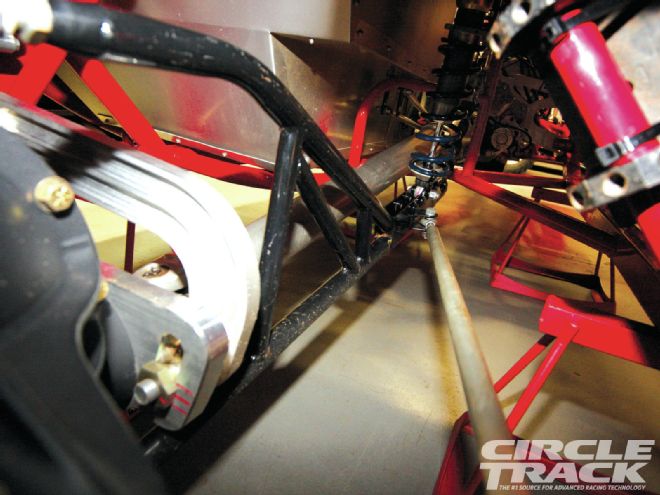 Keeping a dirt car clean is a tough job, but it’s invaluable for both your safety and the durability of the car. The entire driveshaft should be inspected regularly for dents, deep scratches, grooves, or other signs of damage that could portent a catastropic failure at the racetrack. A dirty car makes these signs hard to spot.
Keeping a dirt car clean is a tough job, but it’s invaluable for both your safety and the durability of the car. The entire driveshaft should be inspected regularly for dents, deep scratches, grooves, or other signs of damage that could portent a catastropic failure at the racetrack. A dirty car makes these signs hard to spot.